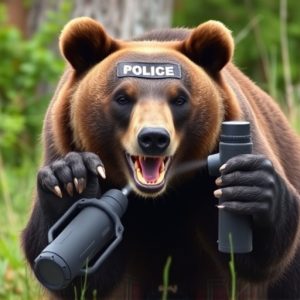Bear Repellent Spray: Essential Range, Choice, and Hiking Tips
Understanding bear behavior highlights the importance of bear repellent spray for hikers, with an ef…….
Understanding bear behavior highlights the importance of bear repellent spray for hikers, with an effective range of 20-30 feet (6-9 meters). This spray disrupts bears' senses without severe harm, ideal as a last resort after other preventive measures. Factors like nozzle type, wind, and bear size impact its effectiveness, emphasizing the need to select high-quality products and use proper techniques, including aggressive movements, for optimal results in bear country.
“Embarking on a hike in bear country? Bear repellent spray isn’t just a convenience—it’s a necessity. Our comprehensive guide explores why this potent tool is crucial for your safety, unraveling bear behavior, and dispelling myths about its effectiveness. We’ll navigate key factors influencing spray range and efficacy, helping you choose the right fit for your hike. From best practices during use to storage tips, ensure your next adventure in nature is safe and sound.”
- Understanding Bear Behavior and Why Spray is Crucial
- Key Factors Affecting Bear Spray Range and Efficacy
- Choosing the Right Bear Repellent Spray for Your Hike
- Best Practices for Using and Storing Bear Spray During Hiking
Understanding Bear Behavior and Why Spray is Crucial
Understanding bear behavior is key to knowing why bear repellent spray is a hiking necessity. Bears are primarily solitary animals, but they can become aggressive if they feel threatened or surprised. They have an excellent sense of smell and will often detect hikers from a considerable distance. When bears do encounter humans, they typically try to avoid conflict, but if they perceive a food source or feel cornered, they may attack.
The best distance for bear spray effectiveness is around 20-30 feet (6-9 meters). Spraying from this range allows you to disrupt the bear’s behavior without causing significant harm. It creates a barrier of capsaicin, the active ingredient in bear spray, which irritates the bear’s eyes, nose, and lungs, encouraging it to leave the area quickly. Remember, using bear spray should be a last resort after all other prevention methods, like making noise while hiking, have been employed.
Key Factors Affecting Bear Spray Range and Efficacy
The effectiveness of bear repellent spray is influenced by several key factors, with the best distance for its usage varying depending on various conditions. One of the primary considerations is the can’s nozzle and misting mechanism. Some sprays emit a fine mist that travels further, while others produce larger droplets that may have a shorter range but are more effective at close ranges. The wind plays a significant role; a calm day allows for greater accuracy and longer reach, whereas strong winds can disperse the spray, reducing its effectiveness over distance.
Another critical factor is the concentration of capsaicin or other active ingredients in the spray. Higher concentrations generally provide better repellency but may also require closer proximity to be effective. The user’s movement and distance from the bear can also impact the spray’s range. Aggressive movements and staying within the optimal range (typically 20-30 feet, or 6-9 meters) increase the likelihood of the spray reaching the bear effectively. Additionally, the type and size of the bear can vary the required distance; smaller bears may be deterred at closer ranges, while larger bears might need more time to react and retreat.
Choosing the Right Bear Repellent Spray for Your Hike
When selecting bear repellent spray, understanding its effectiveness range is key. The best distance for bear spray to work varies based on factors like can size, concentration of active ingredients, and weather conditions. Typically, a 20-foot (6-meter) range is considered optimal for most bear sprays. However, some high-quality options can be effective up to 35 feet (10 meters).
Look for products that meet the recommended standards set by outdoor experts. Check ingredient labels; common active ingredients like capsaicin and pepper oil are known for their effectiveness in deterring bears. Ensure the spray is designed for hiking and has a wide nozzle for better coverage, especially when facing larger bears or those at closer distances.
Best Practices for Using and Storing Bear Spray During Hiking
When hiking in bear country, proper usage and storage of bear repellent spray is paramount to your safety. Always carry bear spray in an easily accessible, exterior pocket or clip it to your harness. Before encountering a bear, ensure the nozzle is facing forward and the safety lever is engaged. At close encounters, pull the trigger slowly while keeping a safe distance—ideally between 20-30 feet (6-10 meters). The spray should create a barrier of irritants that deter the bear from approaching further.
For maximum effectiveness, use bear spray in a wide, sweeping motion across your body and the surrounding area. After spraying, retreat slowly while staying facing the bear until it leaves the area. Regularly check the expiration date and conditions of your bear spray, as they can degrade over time or be affected by extreme temperatures. Store it in a cool, dry place, away from direct sunlight or freezing conditions, to maintain its potency.
When hiking in bear country, carrying bear repellent spray is an essential safety measure. Understanding the right distance for its effectiveness and proper usage techniques can significantly reduce potential risks during your outdoor adventures. By choosing the suitable spray and adhering to best practices, hikers can enjoy a greater sense of security and peace of mind while navigating through diverse landscapes, ensuring a safe and memorable journey.


